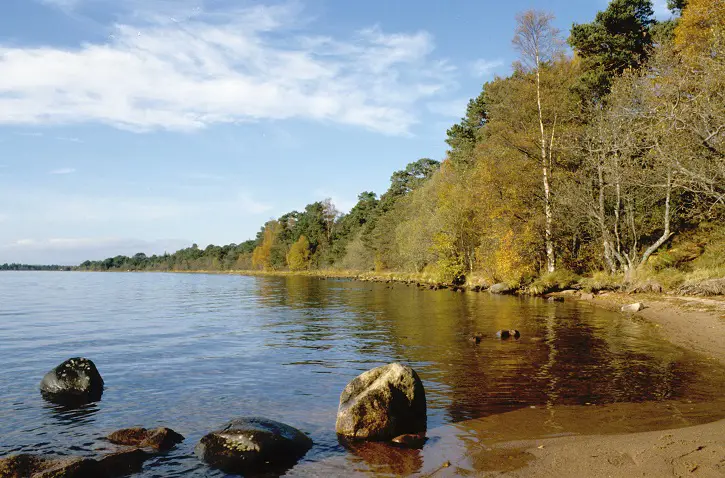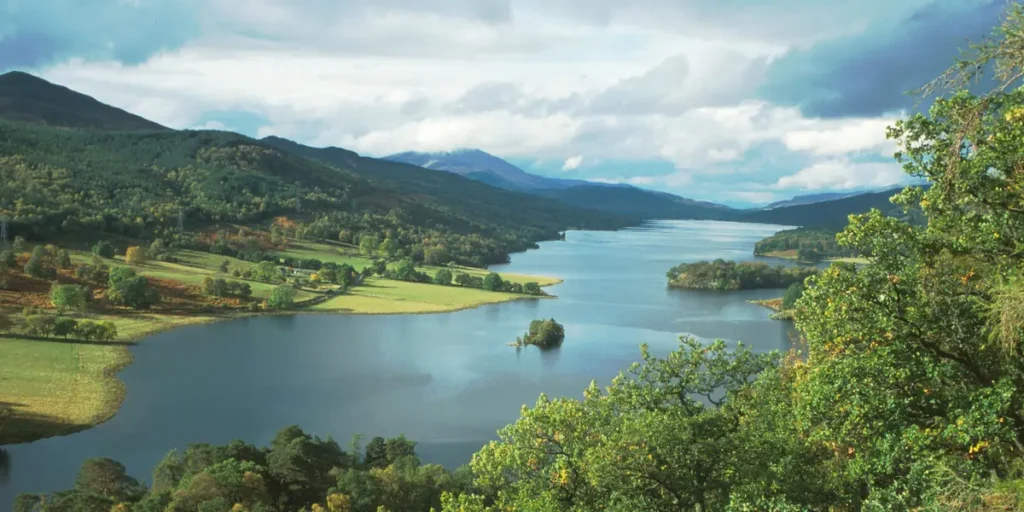Why Visit Scotland’s Forest Parks?
Scotland’s Forest Parks are more than scenic escapes—they are vital ecosystems and cultural touchstones. Covering over 1.4 million hectares, Scotland’s forests support 75% of the nation’s biodiversity, including red squirrels, pine martens, and rare orchids, per Forestry and Land Scotland. They also play a key role in climate mitigation, sequestering 14 million tonnes of CO2 annually. Beyond ecology, these parks preserve historical sites, from ancient cairns to clan battlegrounds, weaving Scotland’s story into their landscapes.
In 2025, the parks align with global trends toward sustainable travel and mental wellness. A Nature study found that spending two hours weekly in green spaces boosts mental health, making these parks ideal for rejuvenation. Posts on X, like @ScotNature’s praise for Galloway’s dark skies, highlight their appeal for stargazing and adventure. Whether you seek hiking, history, or tranquility, these parks offer something for everyone.
The Seven Forest Parks: A Detailed Guide
Each of Scotland’s seven Forest Parks has a distinct character, shaped by its geography, wildlife, and heritage. Below, we explore their highlights, activities, and visitor tips, based on VisitScotland and Forestry and Land Scotland.
1. Argyll Forest Park
- Location: Cowal Peninsula, Argyll and Bute
- Highlights: Nestled between Loch Long and Loch Goil, Argyll is Scotland’s oldest Forest Park, established in 1935. Its dramatic glens, like Glenbranter, and peaks, such as Beinn Ime (1,011m), offer rugged beauty. The park’s ancient oakwoods host otters and golden eagles, per Wildlife Trusts.
- Activities:
- Hiking: The Cowal Way, a 57-mile trail, winds through forests and lochs.
- Cycling: Puck’s Glen has gentle paths for families, while Ardgartan offers challenging routes.
- History: Explore Kilmun Arboretum, home to 150 tree species since the 1930s.
- Visitor Tips:
- Access: Drive from Glasgow (1 hour) or take a ferry to Dunoon. Parking is free at most trailheads.
- Stay: Ardgartan Camping and Caravanning Site offers lochside pitches.
- Best Time: Spring for wildflowers; autumn for vibrant foliage.
- Why Visit: Argyll’s mix of coastal and mountain scenery is perfect for adventurers seeking solitude. A post on X by @ArgyllAdventures called it “Scotland’s hidden gem.”
2. Galloway Forest Park
- Location: Dumfries and Galloway
- Highlights: Spanning 300 square miles, Galloway is the UK’s largest Forest Park and a UNESCO Biosphere. Its Dark Sky Park status, with minimal light pollution, makes it a stargazing haven, per VisitScotland. The park’s lochs, like Loch Trool, and hills, such as Merrick (843m), are home to red deer and black grouse.
- Activities:
- Stargazing: The Scottish Dark Sky Observatory hosts guided sessions.
- Mountain Biking: The 7stanes trails, like Kirroughtree, cater to all levels.
- Wildlife: Spot ospreys at the Red Kite Feeding Station.
- Visitor Tips:
- Access: Drive from Dumfries (45 minutes). Public transport is limited, so plan ahead.
- Stay: Glentrool Camping Site or nearby B&Bs in Newton Stewart.
- Best Time: Winter for clear skies; summer for biking festivals.
- Why Visit: Galloway’s vastness and starry skies offer a unique escape, praised on X by @DarkSkyScot as “cosmic perfection.”
3. Queen Elizabeth Forest Park
- Location: Stirlingshire, near Aberfoyle
- Highlights: Part of Loch Lomond and The Trossachs National Park, this park blends rolling hills with iconic Loch Lomond views. Ben Lomond (974m) and the Duke’s Pass are highlights, with capercaillie and pine martens thriving in its woodlands, per RSPB.
- Activities:
- Hiking: Climb Ben Lomond for panoramic views or stroll the family-friendly Three Lochs Trail.
- Adventure: Go Ape Aberfoyle offers zip-lining and treetop courses.
- Culture: Visit the David Marshall Lodge for local history exhibits.
- _visitor Tips:
- Access: Drive from Glasgow (45 minutes) or take a bus to Aberfoyle.
- Stay: Trossachs Holiday Park has cabins and camping.
- Best Time: Autumn for golden landscapes; spring for birdwatching.
- Why Visit: Its proximity to urban centers and diverse activities make it ideal for families and thrill-seekers. @TrossachsTrek on X raved about its “epic views.”
4. Tay Forest Park
- Location: Perthshire
- Highlights: Stretching across 15 forests, Tay is known for its tranquil rivers, like the Tay, and majestic hills, including Schiehallion (1,083m). The park’s birch and pine woods support wildcats and red squirrels, per Scottish Wildlife Trust.
- Activities:
- Walking: The Fortingall Yew Trail visits one of the world’s oldest trees, estimated at 5,000 years.
- Fishing: The River Tay is renowned for salmon angling (permit required).
- Photography: Allean Forest’s loch views are Instagram-worthy.
- Visitor Tips:
- Access: Drive from Perth (30 minutes). Pitlochry has train connections.
- Stay: Dunkeld’s eco-lodges or campsites like Blair Atholl.
- Best Time: Summer for fishing; winter for crisp hikes.
- Why Visit: Tay’s serene beauty and ancient sites appeal to history buffs and nature lovers. A post on X by @PerthshirePics called it “a photographer’s paradise.”

5. Tweed Valley Forest Park
- Location: Scottish Borders
- Highlights: This park’s seven forests, like Glentress and Cardrona, offer rolling hills and the River Tweed’s gentle flow. It’s a mountain biking mecca, with rare otters and kingfishers along its waterways, per NatureScot.
- Activities:
- Mountain Biking: Glentress’s 7stanes trails range from beginner to expert.
- Walking: The Southern Upland Way cuts through scenic forests.
- History: Visit Neidpath Castle, a 14th-century fortress nearby.
- Visitor Tips:
- Access: Drive from Edinburgh (1 hour). Peebles has bus links.
- Stay: Glentress Forest Lodges or local B&Bs in Innerleithen.
- Best Time: Spring for biking events; autumn for foliage.
- Why Visit: Its world-class biking trails and charming Border towns make it a dynamic destination. @BikeTweed on X dubbed it “MTB heaven.”
6. Loch Lomond and The Trossachs National Park (Forest Areas)
- Location: Central Scotland
- Highlights: While a national park, its forest areas, like those around Loch Katrine, are integral to Scotland’s Forest Park network. Iconic peaks like Ben Venue and diverse wildlife, including ospreys, define its allure, per Loch Lomond & The Trossachs National Park Authority.
- Activities:
- Boating: Cruise Loch Katrine on the SS Sir Walter Scott.
- Hiking: The West Highland Way offers forest trails with loch views.
- Wildlife: Join ranger-led tours to spot eagles and deer.
- Visitor Tips:
- Access: Drive from Glasgow (40 minutes). Balloch has train access.
- Stay: Sallochy Campsite or luxury lodges in Callander.
- Best Time: Summer for boating; winter for quiet hikes.
- Why Visit: Its blend of lochs, forests, and literary history (thanks to Sir Walter Scott) is enchanting. @LochLomondLove on X called it “Scotland’s soul.”
7. Cairngorms National Park (Forest Areas)
- Location: Highlands
- Highlights: The Cairngorms, Scotland’s largest national park, includes vast forest areas like Rothiemurchus and Glenmore. Caledonian pinewoods host capercaillie and crossbills, while peaks like Cairn Gorm (1,245m) offer rugged splendor, per Cairngorms National Park Authority.
- Activities:
- Skiing: Glenmore’s slopes are active in winter.
- Walking: The Speyside Way explores pine forests and whisky distilleries.
- Adventure: Loch Morlich offers kayaking and windsurfing.
- Visitor Tips:
- Access: Drive from Inverness (1 hour). Aviemore has train links.
- Stay: Rothiemurchus Estate’s cabins or Aviemore hostels.
- Best Time: Winter for skiing; summer for water sports.
- Why Visit: Its vast wilderness and year-round activities make it a must-visit. @CairngormsWild on X praised its “untamed beauty.”
Practical Tips for Visiting Scotland’s Forest Parks
To make your visit seamless, consider these tips, informed by VisitScotland and Forestry and Land Scotland:
Planning Your Trip
- Research: Use forestryandland.gov.scot for trail maps and event schedules. Check park-specific sites for seasonal closures.
- Weather: Scotland’s weather is unpredictable. Pack waterproofs, layers, and sturdy boots, especially in winter.
- Accessibility: Most parks offer accessible trails, like Galloway’s Clatteringshaws Loch path. Contact visitor centers for details.
Getting There
- Car: Driving is the easiest way to reach most parks, with free parking at key sites. Rent via Enterprise or Avis in major cities.
- Public Transport: Trains and buses serve hubs like Aberfoyle (Queen Elizabeth) or Aviemore (Cairngorms). Plan routes on Traveline Scotland.
- Eco-Travel: Use electric vehicle charging points, available at parks like Galloway, per ChargePlace Scotland.
Staying Safe
- Navigation: Download apps like OS Maps or carry a compass, as mobile signals can be weak.
- Wildlife: Respect animals; avoid feeding deer or disturbing nests, per Scottish Natural Heritage.
- Fire Safety: Wildfires are a risk. Use designated fire pits and follow park guidelines.
Where to Stay
- Camping: Parks like Argyll and Galloway offer campsites with facilities. Book via forestryandland.gov.scot.
- Lodges and B&Bs: Eco-lodges in Tay or B&Bs in Peebles provide comfort. Check VisitScotland for options.
- Glamping: Cairngorms’ Rothiemurchus offers luxury pods for a unique stay.
What to Bring
- Essentials: Water, snacks, sunscreen, and insect repellent (midges are common in summer).
- Gear: Binoculars for wildlife, a camera for landscapes, and a journal for reflections.
- Guidebooks: Cicerone guides or Forestry and Land Scotland leaflets enhance exploration.
2025 Trends in Scotland’s Forest Parks
Scotland’s Forest Parks are evolving with global eco-tourism trends:
- Rewilding: Cairngorms Connect aims to restore 60,000 hectares, boosting biodiversity, per Rewilding Europe.
- Dark Sky Tourism: Galloway’s stargazing events draw crowds, as noted by @DarkSkyScot on X.
- Wellness Retreats: Yoga and mindfulness sessions in Queen Elizabeth align with wellness trends, per VisitScotland.
- Tech Integration: Apps like Go Jauntly offer guided forest walks, enhancing accessibility.
These trends make the parks vibrant destinations for modern travelers seeking sustainability and serenity.
Challenges and Conservation Efforts
Despite their allure, the parks face challenges:
- Climate Change: Wetter winters and drier summers stress ecosystems, per Met Office.
- Overcrowding: Popular sites like Loch Lomond see litter and trail damage, per National Park Authority.
- Invasive Species: Non-native plants threaten biodiversity, requiring management, per NatureScot.
Forestry and Land Scotland counters these with:
- Reforestation: Planting 25 million trees annually, per forestryandland.gov.scot.
- Community Engagement: Volunteer programs, like those in Tweed Valley, restore habitats.
- Education: Ranger-led tours teach sustainable practices, as shared by @ScotForests on X.
You can support by following “Leave No Trace” principles, volunteering, or donating to Trees for Life.
Why Visit in 2025?
Scotland’s Forest Parks are gateways to adventure, wellness, and heritage. In 2025, their role in combating climate change and fostering biodiversity makes them vital destinations. Whether you’re biking in Tweed Valley, stargazing in Galloway, or hiking in Cairngorms, these parks offer experiences that nourish body and soul. Their accessibility, from Glasgow’s doorstep to remote Highlands, ensures there’s a park for every traveler.
The buzz on X, like @ScotTravel’s call to “explore Scotland’s green heart,” reflects their enduring appeal. As global interest in eco-tourism grows, visiting these parks is both a personal journey and a contribution to planetary health.

Final Thoughts
Scotland’s Forest Parks—Argyll, Galloway, Queen Elizabeth, Tay, Tweed Valley, Loch Lomond and The Trossachs, and Cairngorms—are sanctuaries of green, brimming with beauty, biodiversity, and history. In 2025, they offer a chance to escape, explore, and engage with nature in a world craving connection. From the ancient yews of Tay to the starry skies of Galloway, each park tells a unique story, inviting you to become part of it.
